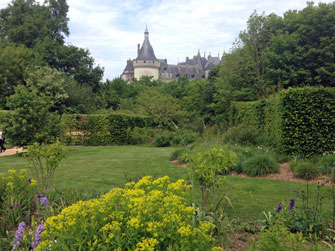Eclectic Estate

Big changes are afoot at the Domaine de Chaumont-sur-Loire, a Loire Valley château/estate best known for its annual garden festival. Formerly the property of the French national government, the entire estate was recently devolved to the Centre region, which brought in a dynamic new director, Chantal Colleu-Dumond. She has already developed a program of art exhibitions for the estate, while leaving the highly successful Festival International des Jardins, now an institution in the world of garden design competitions, to peacefully continue on its way.
Only a two-hour drive or train ride from Paris, the garden festival is a favorite annual outing for many Parisians, but there are now so many things to do on the estate in summer that a visit might merit a weekend rather than a one-day trip.
Château stories
The late-Gothic, early-Renaissance château itself is interesting more for its massive fairytale exterior and the stories associated with it than for its interiors, unappetizingly redecorated by the the château’s last private owner, the Princess de Broglie (née Marie Say). Among the few exceptions is a series of fine 16th- and 17th-century Aubusson and Brussels tapestries.
Italian-born French Queen Catherine de Médicis lived in the château in the 16th century with her astrologers Cosimo Ruggieri and Nostradamus. It was during her stay that the château earned the nickname “Chaud Mont” (hot mount). After the death of her husband, Henri II, the queen forced his mistress, the beautiful and scheming Diane de Poitiers, to give her the Château de Chenonceau in exchange for Chaumont.
In later years, the château was frequented by a number of notable historical figures, including Benjamin Franklin and Madame de Staël, who spent six months there with Benjamin Constant and Madame de Récamier in 1810.
Then, one day in 1875, the 16-year-old Marie-Charlotte Say (1857-1943) passed by the château just before her marriage to Prince Henri Amédée de Broglie. “I want it,” she said, and she got it. Among the guests of this fabulously rich sugar heiress were maharajahs, Queen Isabella II of Spain, King Edward VII of England, the Shah of Iran, actress Sarah Bernhardt and composer Francis Poulenc.
The eccentric and extravagant princess was not particularly well-liked by the locals, however, because she had the village church and cemetery moved away from her property – the noise of funerals was most disturbing to her beauty sleep. The cemetery was replaced with a cemetery for her pet Pekinese dogs and monkeys, whose tombs were later desecrated by disgruntled villagers. She didn’t need the church anyway because she had her own chapel and priest, who would wait patiently to hear her footsteps coming downstairs before starting mass when she slept in of a Sunday morning.
The princess later married true royalty, of the highly degenerate variety, Luis Fernando de Orléans y de Borbón, Infante de España, 31 years her junior (she was 73 when they married), who went through 70 million francs of his wife’s fortune in 10 years, ruining her for the second time. (When her financial advisors had insisted that she economize in 1905, she agreed to give up foie gras at teatime but not to give up her elephant, Miss Pungi, a gift from a maharajah, whose feeding and maintenance represented a huge expense.)
The infamous Infanto, who was arrested for ripping off the ear of a gigolo in Paris, left behind a souvenir at the château: when his car was being restored a few years ago, a vial of cocaine was found in it (and reportedly turned over to the local police). He served as one of the models for Marcel Proust’s Baron de Charlus.
The gardens
For most visitors, the main event is the garden festival, with its 29 small gardens designed by both famous and debutant landscape architects (the latter are selected by a jury). Each year, the festival, which runs from late April to mid-October, has a new theme (it will be “body and soul” for 2010). Previous themes have ranged from “sex” to “sharing,” and the responses of the landscape architects usually range from minimalist to thoughtful and well-meaning to simply beautiful.
If visiting the 29 gardens doesn’t wear you out, you can take a walk in the château’s large park overlooking the River Loire or through the wooded “Valley of Mists,” or visit the tropical-plant-filled greenhouse or the experimental garden.
Lunchtime
For food lovers, the good news is that the estate’s new director has brought back François-Xavier Bogard, the chef who had made the garden festival’s temporary outdoor restaurant-in-a-tent, Le Grand Vélum, into a culinary theater that delighted the eye, the ear (some dishes came with recorded music on a Walkman), the taste buds and the imagination with his wildly creative dishes.
Getting there: By car: A10 Autoroute, exit at Blois or Amboise. By train: from the Gare d’Austerlitz in Paris to Onzain (a 20-minute walk from Chaumont or by taxi: 02 54 20 94 87 or 06 07 36 76 07).
Festival International des Jardins: Chaumont-sur-Loire. Tel.: 02 54 20 99 22. Fax: 02 54 20 99 24. Open daily through mid-October 19, 9:30 a.m.-sunset. Admission: €9. www.domaine-chaumont.fr
Le Grand Velum: 02 54 20 99 79. Fixed-price menu: €32.
© 2008 Paris Update
Reader Reaction: Click here to respond to this article (your response may be published on this page and is subject to editing).
Favorite